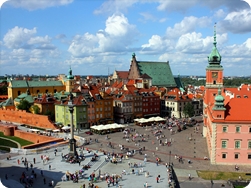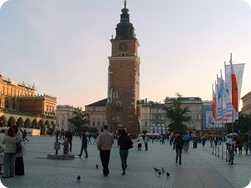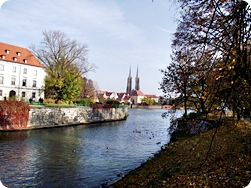
Regional Food of Małopolska
Cuisine of Małopolska
One of the delights of travelling is to sample the food of the part of the world you are visiting. Małopolska will not be a disappointment to your palette. The region has an exciting variety of produce with a unique taste and high nutritional value. There are currently 11 food products from the Małopolska region recognised and protected by European Union laws.
Proziaki - Polish Flat Soda bread is a traditional Polish recipe for a classic soda bread made with flour and sour cream that is cooked in the same way as Middle Eastern pita breads.
If you just go for the usual hamburger and chips you may as well stay at home, as you have wasted your trip.

Prądnicki
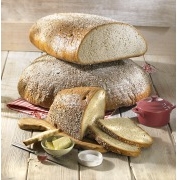 Prądnickijest bread is traditional brown bread, baked with sour dough rye. This is what distinguishes it at first sight from other loaves and is an impressive size. Made in two weights, with a smaller version weighing approximately 4.5 kg, 65 cm long, 35 cm wide by 15 cm height. In contrast, the larger version weighs in at 14 kg, is a meter long and half a meter wide. This bread giant is baked to order and served mainly during big events like at weddings or formal occasions. You can also sometimes see prądnicki round bread, being half a meter in diameter and weighing in at 4.5 kg or thereabouts!
Prądnickijest bread is traditional brown bread, baked with sour dough rye. This is what distinguishes it at first sight from other loaves and is an impressive size. Made in two weights, with a smaller version weighing approximately 4.5 kg, 65 cm long, 35 cm wide by 15 cm height. In contrast, the larger version weighs in at 14 kg, is a meter long and half a meter wide. This bread giant is baked to order and served mainly during big events like at weddings or formal occasions. You can also sometimes see prądnicki round bread, being half a meter in diameter and weighing in at 4.5 kg or thereabouts!
No matter the size and shape of prądnicki it always has a 6 mm thick brown uniform skin with a layer of rye bran. Cutting into the section you will discover it is clear and uniformly porous with a flavour characteristic of the rye sour dough, a slightly tart flavour. The Polish who admire this type of bread appreciate their very long lasting freshness as it keeps for up to two weeks, without loosing the taste. Some even claim that the older prądnicki becomes, the tastier it is, most likely this is due to the ingredients of the dough, of wheat flour, rye flour, bran, yeast, drinking water, salt and cumin are added and sometimes even boiled potatoes or potato flakes.
The history of this bread is inextricably linked with two podkrakowskimi villages (near to the city of Krakow) - Prądnik White and Red, which since the Middle Ages have been famous for baking this amazing bread. Both villages were owned by the bishop of Cracow and Tyniec Abbey. The story of this baked bread is quite well documented with writings found in numerous documents. The name is first mentioned in a letter dated 1421, when the Bishop of Cracow, Albert gave his Świętosław Skowronkowi cook a piece of land lying in Prądnik, while requiring it to provide so-called. rżanego bread on the table for the bishops. All of the collected documents suggest that Prądnik, both white and red, was from around 1479, bakers who supplied the inhabitants of an ancient city which can be considered a great-grandfather of today's bread prądnickiego. According to legend, the mayor of Krakow Wawel offered up to the king after the harvest a baked loaf of bread. This custom was also continued in the days when the ruler transferred to the present day capital, Warsaw. Even during the reign of King Stanislaus Augustus, on the occasion of St. John Mayor of Krakow rulers were found delivering bread to the capital.
Prądnicki bread was enjoyed by many until the early twentieth century. While during the communist period production almost stopped (it was only available to buy on the market in Kleparz, a neighbourhood in Kraków). However, baking resumed after 1989, thanks to the insight and enthusiasm of a baker called Antoni Madej, which by analyzing past documents left behind in the literature and interviews with older residents was able to reproduce the unique Prądnika prądnickiego bread recipe, in time to celebrate the 750 anniversary of the Kraków Bakers' Guild.
From 12 March 2011, Prądnicki bread has been registered under the sign of Protected Geographical Status. This symbol may only apply to bread baked in the administrative boundaries of the city of Kraków.
Pierogi
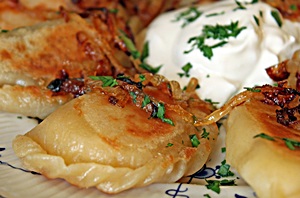 Pierogi (dumplings in English) is a little like fish and chips here in the UK, part of the staple diet for the Polish. Ingredients include, flour, 1 egg yolk, 1 tablespoon of butter, 1 glass of warm water salted, stuffing, 1 kg of potatoes, 0.5 kg of cottage cheese, 2 onions, salt and pepper.
Pierogi (dumplings in English) is a little like fish and chips here in the UK, part of the staple diet for the Polish. Ingredients include, flour, 1 egg yolk, 1 tablespoon of butter, 1 glass of warm water salted, stuffing, 1 kg of potatoes, 0.5 kg of cottage cheese, 2 onions, salt and pepper.
Actually, pierogi is one of the national foods of Poland not just Małopolska. Pierogi are made from a thinly rolled dough and may include various fillings. With many different number of fillings available this makes this Polish food into a snack, spicy first course or even a dessert.
Originally thought to be from China, in Poland pierogi has been around since the thirteenth century. The word pierogi appears for the first time in Polish literature in the second half of the 17th century, possibly around the time when some of the first Polish cookbooks were printed. In the past pierogi were exclusively prepared for the holiday seasons with each holiday having its own type of pierogi assigned.
In times past it was considered to be peasant food, but they eventually gained popularity and spread throughout all the social classes including to the nobles.
Lesser dumplings with prunes, walnuts and honey is one such variation I have come across for Małopolska. Ingredients include 200 g pitted prunes, 100 ml brandy with 200 ml of water, 50 g hazelnuts, 2-3 tablespoons of honey, possible addition: 8 teaspoons of cream 18% and 2 large pinches of cinnamon.
Tatra Oscypek Cheese
Traditional smoked goat cheese called Oscypek shaped a little like a spinning top is made in the Tatra mountains on Poland's southern border.
It´s a salty goat cheese (there is another option that is also mixed with cows milk). The cheese is smoked and infused with rustic motifs. The recipe is strictly protected and even the shape cannot be altered.
Production of cheese in this area dates back to the 15th century and the first recipe for Oscypek was recorded in 1748. Made from unpasteurized milk which is turned into cottage cheese, then this is pressed into wooden moulds, giving the cheese its decorative and distinctive shape. It is then placed in a brine-filled barrel for a few days. Finally, it is placed close to the roof space in a dedicated wooden hut and cured using hot smoke for a period of up to 14 days.
One of the places to buy Oscypek cheese is from the Oscypek market in Zakopane, although it use to be little known outside the region it it now available in supermarkets in Poland.
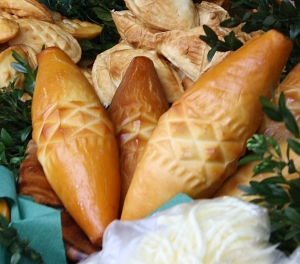
Other Regional Food
Just one of Poland's famous beers, Okocim, is created in the town of Brzesko a brewery founded in 1845.
Małopolska
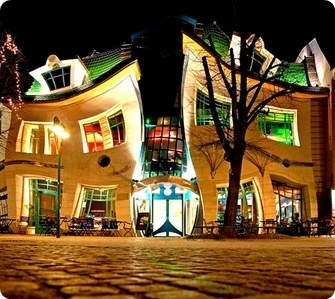
Accommodation
The Małopolska region has every type of accommodation available from simple rooms to the grand hotels and everything in between.
Accommodation

Regional Food
One of the delights of travelling is to sample the food of the part of the world you are visiting. Małopolska will not be a disappointment to your palette.
Regional Food MałopolskaHighlights
Kraków is at the heart of Małopolska and each year thousands of tourists descend on the city to experience the sites and sounds and taste the food on offer. Although, it now has an abundance of fast food outlets and all the modern shops that you can find in any other European city, if you seek out the traditional Polish restaurants and explore it's ancient Jewish quarter, you will discover the real historic capital of Poland.
A place where locals will not most likely send you as this was where during the communism era, an industrial estate was established north east of Kraków.
However, it is well worth a visit as there are the Renaissance and Baroque stylised edifices of Tadeusz Sendzimir Administrative Centre along with Cistercian Abbey found in Mogiła village.
Two rivers flowing from the Carpathian mountains meet here, Kamienica and the Dunajec. Worth a visit if you are heading to the mountains as there is the remnants of a castle and the Gothic collegiate church of St.Margaret built at the turn of the 14th and 15th century. Other sites can be found on the Nowy Sącz page.
Wieliczka and Bochnia are possible the worlds best examples of what can be done artistically to a salt mine. Easily accessible from Kraków there are arranged tours that will take you deep underground to experience a carved domain that is unmissable. You will need good legs for this one as there are many steps!
Małopolska has 6 National Parks and 11 Landscape Parks awaiting your discovery with about 53% of the region having protected status. There is even a desert. The Bledowska Sands is Central Europe's largest accumulation of loose sand in an area away from any sea.
This region is full of hiking trails and is very popular in the Carpathian Mountains. A number of cycle routes criss cross the province. The Polish are great horse lovers so it is not surprising that bridal ways take their pride of place in Małopolska.
53 skiing stations welcome winter sports people to the region catering for all ages and abilities. Since 1980 the Zakopane Ski-jumping Word Cup has taken place each year.
Małopolska is a diverse region with Cracovians in the north and Highlanders in the south. Many of the old traditions survive to the present day with festivals, saints days and traditional food still flourishing.
With about 30% of Poland given over to forests even today, wooden architecture plays a significant roll in the present day and the past. The Carpathian Mountains are a flush with spruce, fir and larch forests as well as the broad leaf oak and beech. The Małopolska Wooden Architecture Route stretching for some 1500km includes 248 buildings with about 50 available for viewing in summer.
UNESCO sites in Poland five of which are located within this region.
Links
Regional Food of Małopolska - David's Travel Guides


